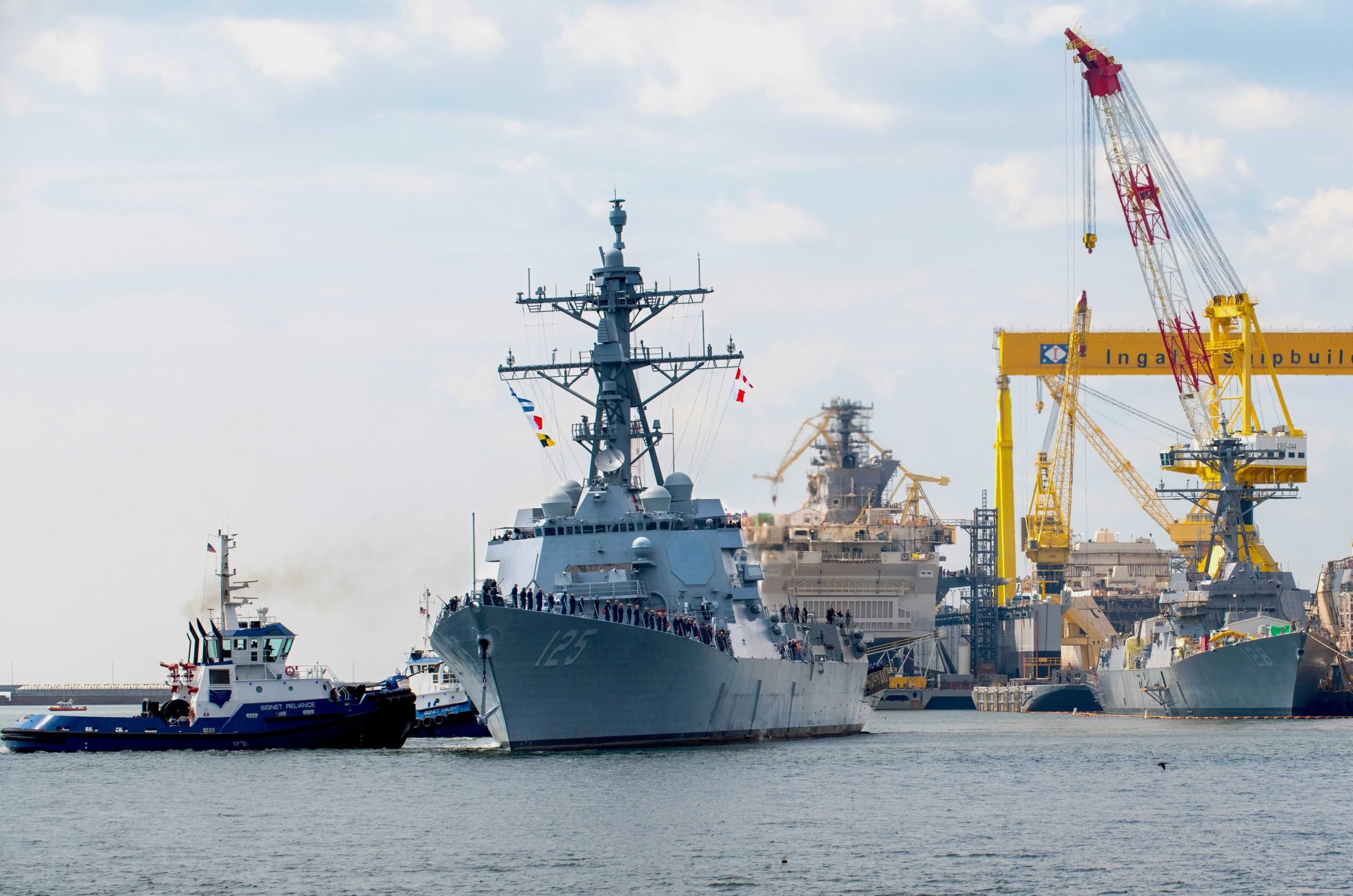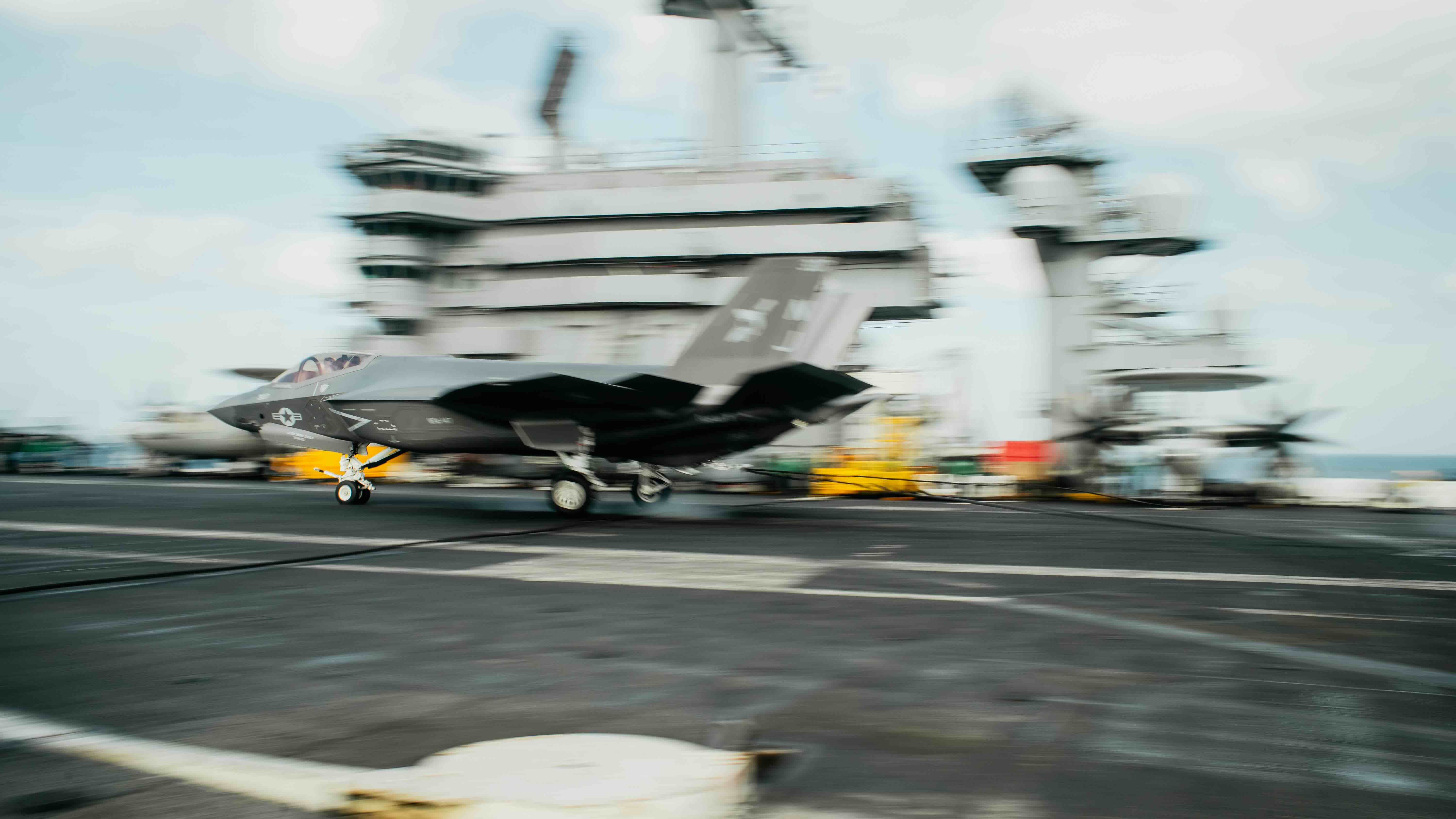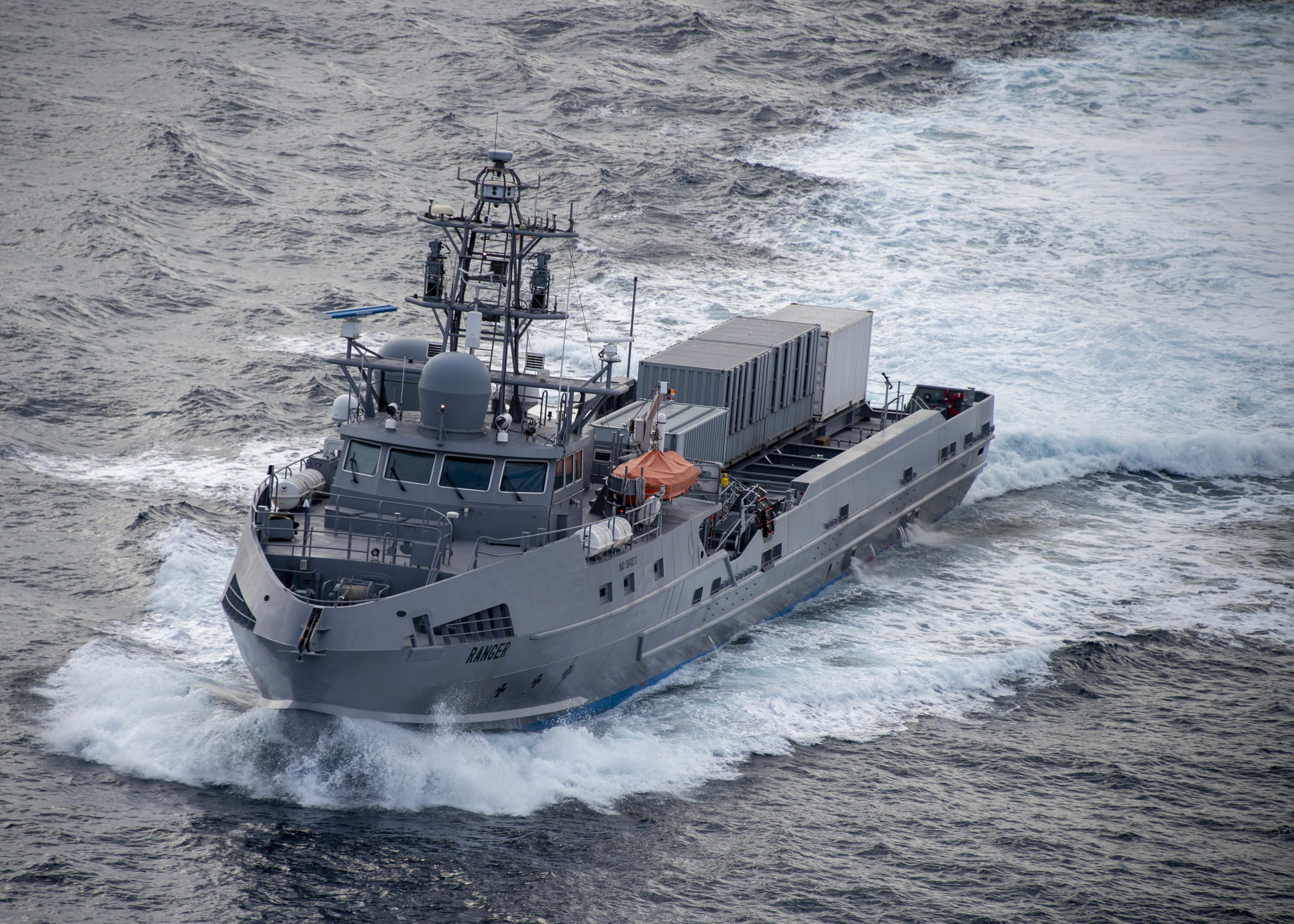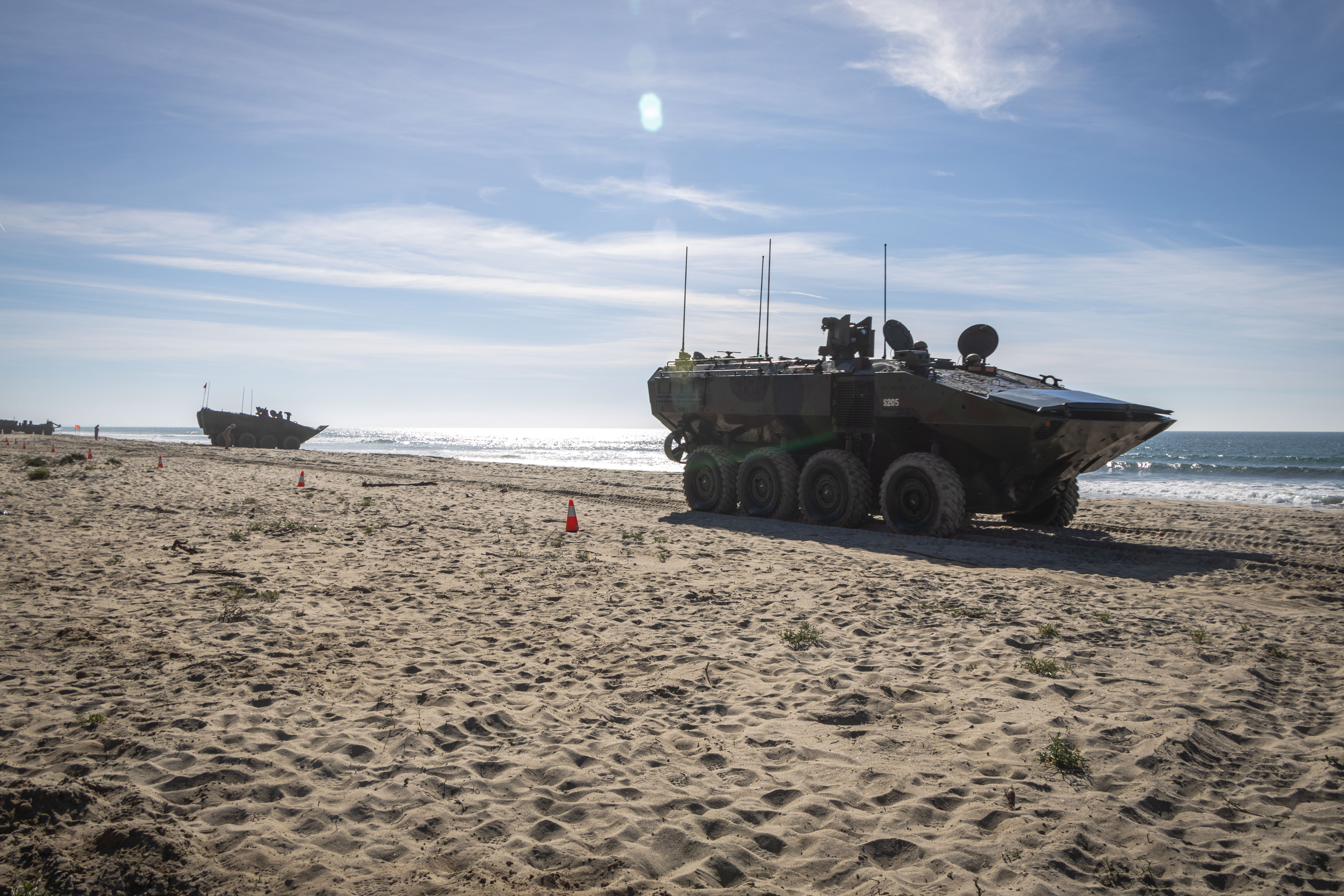MALLORY SHELBOURNE

The Navy wants to buy six battle force ships and decommission 19 ships in the next fiscal year, according to the service’s latest budget request.
Faced with fiscal constraints, the Navy’s Fiscal Year 2025 budget prioritizes readiness over modernization, leading to a smaller shipbuilding request and a delay for several new programs and research and development efforts.
The request, released Monday, is seeking one Virginia-class attack submarine, two Arleigh Burke-class destroyers, one Constellation-class frigate, one San Antonio-class amphibious transport dock and one Medium Landing Ship.
The Department of the Navy is asking for a total of $257.6 billion, with $203.9 billion for the Navy and $53.7 billion for the Marine Corps. The numbers are a .7 percent increase above last year’s request, according to a Navy summary. Last year’s Fiscal Year 2024 submission sought $255.8 billion for the Department of the Navy, broken out with $202.5 billion for the Navy and $53.2 billion for the Marine Corps.
The Navy’s portion of the budget breaks down to $70.2 billion in operations and maintenance funding, $63.3 billion in procurement, $43.8 billion for military personnel, $22.7 billion in research and development funding, and $3.9 billion for military construction.
This year’s request continues the Navy’s plans to divest of older platforms, asking to decommission 10 hulls before the end of their service lives and nine additional ships. For the early retirements, the service wants to decommission two cruisers, the first four Expeditionary Fast Transports, one Whidbey Island-class docking landing ship, one Expeditionary Transfer Dock and two Littoral Combat Ships. Those ships are USS Shiloh (CG-67), USS Lake Erie (CG-70), USNS Spearhead (EPF-1), USNS Choctaw County (EPF-2), USNS Millinocket (EPF-3), USNS Fall River (EPF-4), USS Germantown (LSD-42), USNS John Glenn (ESD-2), USS Jackson (LCS-6) and USS Montgomery (LCS-8).
The Navy performed a “hull-by-hull analysis” of each ship to determine which ones to retire early, Navy Under Secretary Erik Raven told reporters Friday ahead of the budget rollout.
“On [the] Littoral Combat Ship, very consistent with prior year’s message that we look at the requirements for LCS and we find we have hulls excess to the validated requirements,” Raven said. “So the divestments proposed in this year’s budget are very consistent with that analysis.”
Raven justified the LSD retirement by citing the Navy’s plans to keep buying LPD-17 Flight II ships, a line the Navy halted procurement for last year.
The Pentagon built this year’s budget under restrictions of the Fiscal Responsibility Act, which limits the Biden administration’s spending on national defense to $895 billion. In adhering to the FRA, Raven said the Navy prioritized people and platforms currently in the fleet over modernization, meaning it delayed the development of some future programs.
“In terms of what comes at the top of the list it is readiness, it is people. It is the today issues that we have to get on top of,” Raven said. “Where our guidance directs us to take risk is in future modernization when there are tough choices to be made.”
“So if you look at F/A-XX or the other X programs, we knowingly took risk in the schedule for the development of those programs in order to prioritize those key investments, whether that’s readiness, or investing in our people, or undersea, to make sure that we make those programs whole,” Raven added, referring to the Navy’s next generation fighter program and other new programs like the next-generation submarine program, or SSN(X).
On the personnel side, The FY 2025 request includes a 4.5% pay increase for active-duty military and a 2% increase for civilians.
Shipbuilding

Jack H. Lucas (DDG-125) leaves from Ingalls Shipbuilding on Sept. 26, 2023.
The overall request for the shipbuilding account is $32.4 billion, which is a $400 million decrease from Fiscal Year 2024’s request for $32.8 billion. The FY 2025 request for six ships is a decrease from the projected seven the Navy said it would buy in last year’s five-year budget outlook. The previous plan forecast the Navy buying two Virginia-class attack submarines, two Arleigh Burke-class destroyers, one Constellation-class frigate, one Medium Landing Ship, and a T-AGOS(X) ocean surveillance ship instead of the LPD.
In FY 2025, the Navy is notably asking for one Virginia-class submarine in, despite the previous plans to keep consistently buy two attack boats each year. Asked why the Navy cut one submarine from the request, Raven cited the fact that industry is not building the attack boats at the two-per-year rate that the Navy has been buying the Virginias. Industry is currently delivering 1.3 attack boats per year.
“We believe that the best choice for where we are in the Virginia-class program is to make substantial investments in the submarine industrial base to make sure that we get these programs on the cadence that we need,” Raven said. “And looking at where we are in procurement, we judged that funding 9 out of the 10 Virginia class that are funding in the ‘25 budget is the right move.”
A senior defense official echoed Raven’s rationale about industry when asked about the Navy’s cut.
“I think everybody felt that it’s time for a fresh approach and refresh,” that official said. “There’s a lot of money in the industrial base to try and change the dynamics so that when we do go back to ordering two subs a year, we are more closely aligned to being able to get two subs a year built.”
To that end, Raven said the Navy is making “significant investments in the submarine industrial base” across the Fiscal Year 2025 five-year budget lookout. In addition to the $2.4 across last year’s Future Years Defense Plan, Raven said this request is seeking another $8.8 billion for the submarine industrial base across the FY 2025 FYDP.
This year’s request also includes a new shipbuilding program called the light replenishment oiler, which the Navy plans to begin buying in Fiscal Year 2027.
“That is a capability gap that we needed to fill,” Rear Adm. Ben Reynolds, the Navy deputy assistant secretary for budget, said of the light replenishment oiler.
By asking to buy an LPD-17 Flight II ship in FY 2025, the service ended its so-called “strategic pause” on purchasing amphibious transport docks. The latest submission shows the Navy buying another LPD in FY 2027 and another in FY 2029, which adheres to HII Ingalls Shipbuilding’s calls to build the platforms on two-year centers to maintain a healthy supply chain in the industrial base.
Aviation

An F-35C Lightning II attached to Strike Fighter Squadron (VFA) 147 lands on the flight deck of Nimitz-class aircraft carrier USS George Washington (CVN-73) in the Atlantic Ocean, Feb. 28, 2024.
For aviation procurement, the Navy is seeking $16.2 billion to buy a total of 75 aircraft. The buy is $900 million below last year’s $17.3 billion aircraft procurement request.
The Fiscal Year 2025 procurement profile includes nine F-35C Joint Strike Fighters for the Navy, four F-35Cs for the Marine Corps, 13 F-35Bs for the Marine Corps, 15 Multi-Engine Training Systems for the Navy, 12 Multi Engine Training Systems for the Marine Corps, 19 CH-53K King Stallion heavy-lift helicopters for the Marine Corps, and three MQ-25A Stingrays for the Navy’s carrier air wing, according to a service summary.
The Navy will kick off a two-year block buy for the Marine Corps’ CH-53Ks in FY 2025, according to a Navy summary of the request. The Marine Corps’ aircraft are purchased using the Navy’s aircraft procurement account.
While the service is continuing its development of the F/A-XX next-generation fighter program, the FY 2025 request is seeking significantly fewer research and development dollars for the effort. While last year’s request sought $1.5 billion for F/A-XX, this year’s submission is asking for $454 million.
“We re-phased across the FYDPs,” Reynolds told reporters Friday of the Navy’s cut in funding to the program.
The F/A-XX funding is specifically for research and development of the fighter and does not include funding spent on the Next Generation Air Dominance family of systems, some of which are classified, Reynolds said.
Weapons Systems

Lockheed Martin LRASM Missile during a 2018 test.
The Navy’s weapons procurement request seeks to build upon the multi-year procurement strategies for several munitions programs – the Standard Missile 6, the Long Range Anti-Ship Missile, the Naval Strike Missile, and the Advanced Medium Range Air-to-Air Missile – that the service asked to start in FY 2024.
The defense spending bill for FY 2024 has yet to pass Congress, so the funding for those multi-year procurement schemes is not technically secured yet. Reynolds told reporters on Friday that the Navy crafted the overall FY 2025 request under the assumption that it would have an appropriations bill for FY 2024. The Pentagon is currently operating under a continuing resolution and the defense spending bill for FY 2024 remains stalled in Congress. .
The Navy wants to buy 125 SM-6s, which the service has consistently asked for in the last few budget cycles. This year’s request also asks for 22 Tactical Tomahawks for the Navy and Marine Corps, 102 Naval Strike Missiles for both services, 30 LRASMs, 261 AMRAMs, and 60 LRASMs Extended Range.
The request does not ask to buy any Conventional Prompt Strike weapons. CPS is a hypersonic missile that the Navy planned to field on the Zumwalt-class guided-missile destroyer in FY 2025 and the Virginia-class attack submarine in FY 2028. But the plans to field the weapon on the Zumwalt-class destroyers are delayed until FY 2026, Reynolds told reporters.
“We’re re-phasing Conventional Prompt Strike to allow our tech team and our development to catch up,” Reynolds said.
“The Department continues to pursue critical milestones on the path to fielding CPS on USS ZUMWALT in the mid-2020’s,” a Navy spokesperson told USNI News.
Unmanned Systems

Large unmanned surface vessel Ranger transits the Pacific Ocean to participate in Exercise Rim of the Pacific (RIMPAC) 2022.
The Navy is continuing research and development efforts for its unmanned systems programs, but two of the larger platforms are delayed.
The service is asking for $54 million in research and development funding for the Large Unmanned Surface Vehicle and $21 million in R&D funding for the Extra Large Unmanned Undersea Vehicle. It’s a substantial decrease compared to the FY 2024 request, which asked for $117 million for LUSV and $104 million for XLUUV. That decrease is due to the delays for both programs, Reynolds told reporters.
“Where we have one to two unmanned systems that we’re experiencing any kind of technical difficulty, we’re working to move those, re-phase those across the FYDP,” Reynolds said. “So LUSV, for example, we’re moving that from ’25 to ’27.”
On the surface and sub-surface side, the smaller platforms are progressing better than the larger platforms, he noted.
“Some of those platforms are doing very well and transitioning from R&D into procurement,” Reynolds said, citing the small UUVs.
Marine Corps Procurement

U.S. Marines maneuver an Amphibious Combat Vehicle on the beach during the Amphibious Assault School Transition Training Unit Operator Certification Course at Marine Corps Base Camp Pendleton, California, Dec. 14, 2023.
The Marine Corps request for Fiscal Year 2025 breaks down to $17.4 billion in operations and maintenance funding, $13.8 billion in procurement funding, $18.1 billion in personnel funding, $3 billion in research and development funding and $1.4 billion in military construction funding.
The service is asking for 80 Amphibious Combat Vehicles, the same number it sought in FY 2024. The Marine Corps wants to buy 674 Joint Light Tactical Vehicles, 123 Anti-Armor Missile Javelins, eight Long Range Fires, and 12 Medium Range Interceptor Capability launchers and missiles.
No comments:
Post a Comment